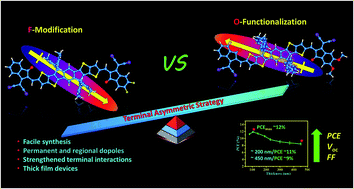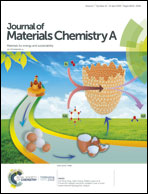Tuning the dipole moments of nonfullerene acceptors with an asymmetric terminal strategy for highly efficient organic solar cells†
Abstract
The π–π stacking of terminal electron-deficient groups is known to support the main charge transport pathway in acceptor–donor–acceptor type fused-ring electron acceptors (FREAs). Interactions between terminal groups influence molecular stacking and ultimate photovoltaic performances. Herein, we designed two novel asymmetric FREAs bearing different polar terminal groups via a facile stepwise Knoevenagel condensation. The combination of two terminal groups with differing polarities in a single molecule fine-tuned the absorption and energy levels. Furthermore, the different terminal groups induced a permanent dipole moment over the whole molecule with regional dipole moments at the end regions. These effects enabled control over intermolecular interactions, crystallization properties, and the blended microscopic morphology. Single-junction solar cells based on the asymmetric a-IT-2OM in combination with the widely used polymer donor PBDB-T yielded power conversion efficiencies (PCEs) as high as 12.07%, which represents a 30%-increase compared with that of the control device. Notably, devices based on PBDB-T/a-IT-2OM retained high PCEs greater than 11% for active layer thicknesses up to 200 nm; PCEs of approximately 9% were maintained even at a thickness of 450 nm. These findings offer a route to high performance FREA molecules for thick-film solar cell devices and also provide a novel asymmetric molecular design strategy.



 Please wait while we load your content...
Please wait while we load your content...